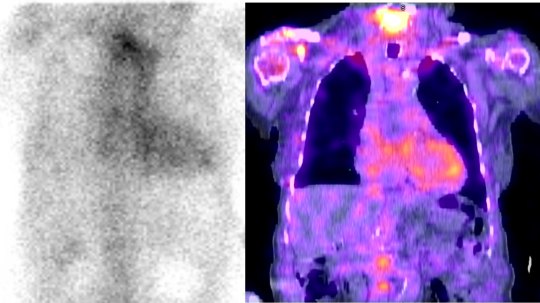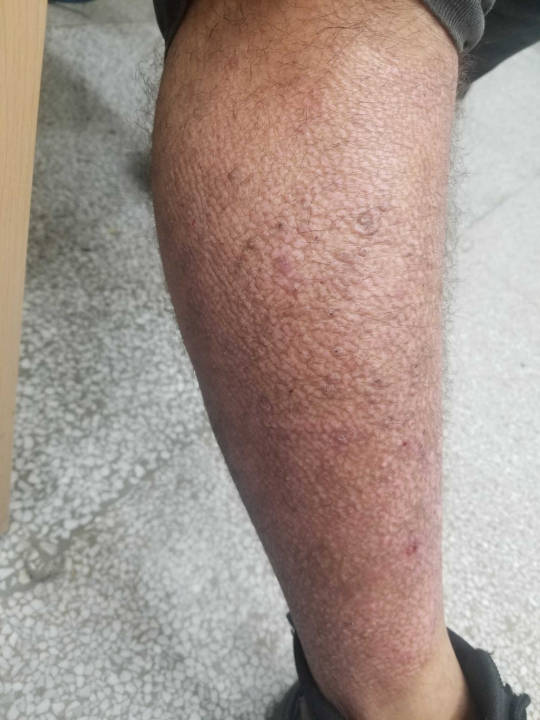#amyloidosis
Link
A central role for amyloid fibrin microclots in long COVID/PASC: origins and therapeutic implications
Abstract
Post-acute sequelae of COVID (PASC), usually referred to as ‘Long COVID’ (a phenotype of COVID-19), is a relatively frequent consequence of SARS-CoV-2 infection, in which symptoms such as breathlessness, fatigue, ‘brain fog’, tissue damage, inflammation, and coagulopathies (dysfunctions of the blood coagulation system) persist long after the initial infection. It bears similarities to other post-viral syndromes, and to myalgic encephalomyelitis/chronic fatigue syndrome (ME/CFS). Many regulatory health bodies still do not recognize this syndrome as a separate disease entity, and refer to it under the broad terminology of ‘COVID’, although its demographics are quite different from those of acute COVID-19. A few years ago, we discovered that fibrinogen in blood can clot into an anomalous ‘amyloid’ form of fibrin that (like other β-rich amyloids and prions) is relatively resistant to proteolysis (fibrinolysis). The result, as is strongly manifested in platelet-poor plasma (PPP) of individuals with Long COVID, is extensive fibrin amyloid microclots that can persist, can entrap other proteins, and that may lead to the production of various autoantibodies. These microclots are more-or-less easily measured in PPP with the stain thioflavin T and a simple fluorescence microscope. Although the symptoms of Long COVID are multifarious, we here argue that the ability of these fibrin amyloid microclots (fibrinaloids) to block up capillaries, and thus to limit the passage of red blood cells and hence O2 exchange, can actually underpin the majority of these symptoms. Consistent with this, in a preliminary report, it has been shown that suitable and closely monitored ‘triple’ anticoagulant therapy that leads to the removal of the microclots also removes the other symptoms. Fibrin amyloid microclots represent a novel and potentially important target for both the understanding and treatment of Long COVID and related disorders.
#Fibrin amyloid microclots#amyloidosis#covid-19 vaccine#covid-19#spike protein#print this off later#fibrinaloids#Resia Pretorius#fav#Pathology#most important#important
18 notes
·
View notes
Text

Today's less common nuclear medicine study is Tc-99m-pyrophosphate (PYP) for evaluation of suspected cardiac amyloidosis. In such patients, PYP has excellent specificity for TTR amyloidosis.
Case shows a planar image (left) from a PYP scan of an elderly patient with suspected cardiac amyloidosis. SPECT CT (right) confirms that the uptake localizes to the myocardium. Based on ASNC guidelines, this is "strongly suggestive" of TTR amyloidosis (myocardial uptake greater than rib uptake).
Note that a negative scan essentially rules out TTR amyloidosis but does not exclude AL amyloidosis, and patients with negative scans may require myocardial biopsy.
0 notes
Text
Localised Cutaneous Amyloidosis of the Glans Penis: A Case Report and Review of the Literature by Victoria Hyett in International Journal of Clinical Images and Medical Reviews
Abstract
Amyloidosis represents a notable cause of morbidity within the developed world. Urological presentations of systemic or localised amyloidosis are rare, with penile amyloidosis being poorly reported. We performed a literature review investigating cases of penile cutaneous amyloidosis via the PubMed database during March 2020, in conjunction with clinical review of a local patient presenting with a penile lesion. Our patient is a 60-year-old uncircumcised, caucasian male presenting with a longstanding history of 2 irregular lesions affecting his glans penis and a further 2 lesions affecting the inner surface of his prepuce. He underwent excision biopsy of the largest lesion which represented cutaneous amyloid deposits. He underwent immunological testing for systemic disease which was negative.
In current literature, there are 13 cases of cutaneous amyloidosis affecting the glans penis, with 1 of those having evidence of extra genitourinary amyloid deposits. All the documented cases were treated with local excision and investigation for systemic disease. It is important to recognise alternative diagnoses in patients presenting with penile lesions. Despite cutaneous amyloidosis mimicking malignancy macroscopically, the morbidity and mortality is lower in comparison to penile cancer. Treatment remains surgical excision of the lesion and further investigations to exclude systemic disease.
Introduction
Amyloidosis is a notable cause of morbidity, and in some cases mortality within the developed world. Urological presentations of systemic or localised amyloidosis are rare, with primary penile amyloidosis being poorly reported in the literature. It can commonly mimic malignancy on imaging and macroscopically, thus representing an important differential diagnosis to be aware of when examining and investigating a penile lesion.
Case Presentation
A 60-year-old uncircumcised, Caucasian male was referred with multiple longstanding granular lesions of his penis. His past medical history included hypertension and insulin dependent type 2 diabetes. On initial assessment there were two irregular granular lesions on his glans penis and two further similar lesions on the inner prepuce. These were initially thought to be malignant and an excision biopsy of the largest one was performed.
The histopathological examination showed an abundance of relatively amorphous pink material in the superficial to mid dermis with positive Congo red staining and mild apple-green birefringence in keeping with cutaneous amyloidosis. Further analysis with immunohistochemical staining of the sample by the National Amyloidosis Centre confirmed this result and determined this to be of the AL Kappa subtype.
Following investigation under the care of the haematology department with serum free serum light chains, electrophoresis and Bence Jones’ protein, there was no evidence of systemic amyloidosis or multiple myeloma. A diagnosis of cutaneous AL amyloidosis of Kappa subtype affecting the glans penis and prepuce was made.
The patient underwent a circumcision for localised treatment of the remaining preputial lesions. The remaining glandular one was deemed high risk for meatal stenosis due to its proximity to the urethral meatus and therefore not excised.
The patient remains well under yearly review from the National Amyloidosis Centre.
Discussion
The term ‘Amyloid’ was first coined by Virchow in the 19th century to describe a macroscopic tissue abnormality characterised by a positive iodine staining reaction. Subsequent technological advancements in light microscopy furthered Virchow’s description to include distinct birefringence of the amyloid deposits when stained with Congo red dye [1].
The pathophysiology of amyloidosis stems from a failure of proteolysis of misfolded proteins resulting in oligomeric conglomerates referred to as amyloid fibrils. As amyloidosis is caused by misfolded proteins, there are multiple classifications of the disease specifically related to the original protein involved. All of the involved proteins may form extracellular deposits and lead to subsequent organ dysfunction [2]. The most common subtypes of amyloidosis include amyloid light chain (AL), the origin of which is an immunoglobulin arising from plasma cells, and amyloid associated (AA), arising from a non-immunoglobulin synthesised by the liver. Further classification can be made by the clinical presentation of the proteinaceous deposit; whether it be systemic or localised, and the clinical syndrome it produces.
The amyloid Light Chain (AL) subtype is characterized by clonal plasma cell dyscrasia, similarly to multiple myeloma [3]. This results in a failure to produce the classical alpha-helix configuration of either kappa or lambda light chains, instead producing a beta-pleated sheet which is inherently insoluble. Classically there is involvement of the kidneys, heart or nervous system however involvement of many organ systems has been documented.
Cutaneous amyloid deposits can be seen in both systemic and localized disease. Commonly up to 40% of systemic AL amyloidosis sufferers complain of epidermal disease, which reflects amyloid deposition within the capillaries of the skin involved. Cutaneous disease typically presents as petechiae or purpuric lesions, yellow macular or nodular lesions. There are also macular and lichen subtypes which can be associated with systemic connective tissue diseases.
Statistically, within the UK the age-adjusted prevalence of amyloidosis is between 5.1 and 12.8 per 1 million per year*. Approximately 10-20% of cases remain localised, with the remainder of cases being classified as systemic disease. Although the localised form is rarer, it carries a better prognosis [5]. Rarer still is localised penile amyloidosis, with only 14 documented cases, including ours, on literature review.
Merika et al. comments on the low prevalence of systemic disease in those presenting with cutaneous penile amyloid lesions as the primary presenting complaint. Their study also highlights the increased rate of primary nodular amyloidosis amongst those with penile cutaneous lesions [4]. Of the confirmed cases of cutaneous amyloidosis of the glans penis, only one reported a second site affected, namely the trachea. This was subsequently found to be a lone deposit, with no further evidence of widespread disease identified; however, this does not exclude the possibility of this representing systemic amyloidosis [16].
Of the cases identified, most were diagnosed on a serological and histological basis, more in depth modalities such as serum amyloid protein component (SAP) scintigraphy and genetic testing were not performed routinely. SAP scintigraphy is highly sensitive for AL and AA amyloidosis (90% for both subtypes), with a specificity of 93%. The use of SAP scintigraphy may give a more definitive answer regarding the presence of systemic disease however the modiality itself is often not available in local centres [17,18].
Treatment of the lesions remains case dependent and requires a multi-disciplinary approach [19]. The underlying amyloid subtype also greatly influences management. In systemic AL amyloidosis, treatment aims to suppress plasma cell production of amyloid which predominantly involves using dexamethasone and mephalan, an oral chemotherapeutic agent, alongside supportive care for the underlying organs involved. Similarly, AA amyloidosis requires management of the underlying disease process often involving immunomodulation [19]. Localised cutaneous amyloidosis is typically managed by surgical excision, or laser ablation, systemic chemotherapeutic agents are usually not employed due to their side effect profile [16]. The majority of cases reported were treated with local excision as in our case.
Conclusion
These cases highlight the importance of consideration of alternative diagnoses in patients presenting with cutaneous penile lesions. Fortunately, despite penile cutaneous amyloidosis mimicking malignancy, the morbidity and mortality are low due to the low incidence of systemic amyloidosis in patients who present with a penile lesion. Treatment remains local excision of the lesion, histological and immunochemical confirmation of the amyloid subtype and further investigations to exclude systemic disease. Consideration could be made for the introduction of SAP scintigraphy in these cases, however the benefit of this remains unclear with such a small demographic to review.
For more details: https://ijcimr.org/editorial-board/
#Amyloidosis#Urological#poorly#immunological#genitourinary#macroscopically#amorphous pink#Victoria Hyett#ijcimr
0 notes
Text
Amyloidosis: Causes, Risk Factors, diagnosis & treatment

Amyloidosis is a rare, progressive, and often fatal condition caused by the accumulation of abnormal proteins called amyloid in various organs and tissues throughout the body.
Amyloid is an abnormal protein usually produced by the body as a response to an injury or infection. In amyloidosis, the body has an excessive amount of amyloid, accumulating in the organs and tissues, causing damage and dysfunction. View More.
0 notes
Photo


You are strong! But some days we all need a little more awareness, and a few extra spoons! (in burgundy!)
The burgundy awareness ribbon represents those with
amyloidosis, antibody, syndrome, av malformation, brain aneurysm, malformation, cystic hygroma, factor v leiden, headache, hemangioma, hemiplegic migraine, hemochromatosis, hirschsprung’s disease, hughes syndrome, meningitis, multiple myeloma, parkes weber syndrome, birthmark
And the dark and light versions of the design are available on my Threadless store in a variety of products and background colours!
threadless dark- https://meridiandesigns.threadless.com/designs/burgundy-awareness-pocket-dark
threadless light- https://meridiandesigns.threadless.com/designs/burgundy-awareness-pocket-light
facebook ★ instagram ★ twitter ★ pinterest
#burgundy#red#spoonie#chronic illness#invisible illness#chronic pain#disability#health#love#awareness#fatigue#amyloidosis#antibody syndrome#brain aneurysm#malformation#cystic hygroma#headache#hemangioma#migraine#hemochromatosis#hirschsprung#meningitis#multiple myeloma#birthmark#parkes weber syndrome
0 notes
Text
मुशर्रफ की सेहत को लेकर सोशल मीडिया पर उड़ी अफवाह, परिवार ने कहा, 'दुआ करें'
मुशर्रफ की सेहत को लेकर सोशल मीडिया पर उड़ी अफवाह, परिवार ने कहा, ‘दुआ करें’
Image Source : TWITTER.COM/FABIHA1810
Former Pakistan President Pervez Musharraf.
Highlights
मुशर्रफ को बेनजीर भुट्टो की हत्या और एक मौलकी की मौत के केस में भगोड़ा घोषित किया गया है।
पाकिस्तान के पूर्व तानाशाह मुशर्रफ मार्च 2016 में दुबई गए थे और तब से वापस नहीं लौटे हैं।
पाकिस्तान के पूर्व सूचना मंत्री चौधरी फवाद हुसैन ने बताया कि मुशर्रफ की हालत नाजुक बनी हुई है।
Pervez Musharraf: पाकिस्तान…

View On WordPress
#Amyloidosis#Asia Hindi News#Pervez Musharraf#Pervez Musharraf Death News#Pervez Musharraf Health#Pervez Musharraf Latest News#Pervez Musharraf News#Pervez Musharraf Organs Failure#Pervez Musharraf Pakistan#Pervez Musharraf UAE#परवेज मुशर्रफ#परवेज मुशर्रफ खबर#परवेज मुशर्रफ लेटेस्ट न्यूज#परवेज मुशर्रफ स्वास्थ्य
0 notes
Text
tagged by the lovely natalia <33 @jiminsproof a bit ago to reveal some "lasts" so, without further ado:
last song: american teenager, ethel cain - song of the year for the second year running, i fear. preacher's daughter you will always be famous
last movie: freaky friday - jamie lee curtis AND lindsay lohan milf performances???? five stars. put pink slip's take me away on spotify immediately
currently watching: house m.d. - binged my way through six seasons already and i'm showing no signs of slowing down. at this point i'm one more character playlist curation away from being institutionalised
currently reading: coded messages that kim taehyung leaves for me in his promotions and mvs. oh and high fidelity
current obsession: jungle's music videos. back on 74 was obviously the catalyst here but they're all phenomenal. additionally i have a pretty serious below deck problem
and there you have it. tagging a handful of favs if you feel so inclined: @cordiallyfuturedwight @aprylynn @pauls-mccharmly @somebodydoeslove @banghwa @monismochi @eoieopda @btscontentenjoyer @letmelovekoo @spicyclematis
#thanks for the tag my love!!#this was a fun one#here's how freaky friday can still win an oscar in the year of our lord 2024#mwah#tag#bingeing house is all fun and games until you develop a Symptom and start self diagnosing amyloidosis#and high fidelity... adore the film and loved the series. only started the book today but what could possibly go wrong#feel free to ignore the tags and i apologise if you've already done this one and i missed it but legally i think you have to do it again#anyway. merry jungkook (3)d-day to all and to all a good night#i'll see you on the other side#(the other side no doubt being me desperately supressing chimpanzee noises in the workplace tomorrow morning)
24 notes
·
View notes
Text
How the fuck am I getting all these insane cases within 2 months of starting clinical medicine residency??
#got ATTR amyloidosis now...#in a patient who had a heart attack 30 days ago#who had a stroke with serious sequelae 3 years ago...
39 notes
·
View notes
Link
Prevalence of symptoms, comorbidities, fibrin amyloid microclots and platelet pathology in individuals with Long COVID/Post-Acute Sequelae of COVID-19 (PASC)
Abstract
Background
Fibrin(ogen) amyloid microclots and platelet hyperactivation previously reported as a novel finding in South African patients with the coronavirus 2019 disease (COVID-19) and Long COVID/Post-Acute Sequelae of COVID-19 (PASC), might form a suitable set of foci for the clinical treatment of the symptoms of Long COVID/PASC. A Long COVID/PASC Registry was subsequently established as an online platform where patients can report Long COVID/PASC symptoms and previous comorbidities.
Methods
In this study, we report on the comorbidities and persistent symptoms, using data obtained from 845 South African Long COVID/PASC patients. By using a previously published scoring system for fibrin amyloid microclots and platelet pathology, we also analysed blood samples from 80 patients, and report the presence of significant fibrin amyloid microclots and platelet pathology in all cases.
Results
Hypertension, high cholesterol levels (dyslipidaemia), cardiovascular disease and type 2 diabetes mellitus (T2DM) were found to be the most important comorbidities. The gender balance (70% female) and the most commonly reported Long COVID/PASC symptoms (fatigue, brain fog, loss of concentration and forgetfulness, shortness of breath, as well as joint and muscle pains) were comparable to those reported elsewhere. These findings confirmed that our sample was not atypical. Microclot and platelet pathologies were associated with Long COVID/PASC symptoms that persisted after the recovery from acute COVID-19.
Conclusions
Fibrin amyloid microclots that block capillaries and inhibit the transport of O2 to tissues, accompanied by platelet hyperactivation, provide a ready explanation for the symptoms of Long COVID/PASC. Removal and reversal of these underlying endotheliopathies provide an important treatment option that urgently warrants controlled clinical studies to determine efficacy in patients with a diversity of comorbidities impacting on SARS-CoV-2 infection and COVID-19 severity. We suggest that our platelet and clotting grading system provides a simple and cost-effective diagnostic method for early detection of Long COVID/PASC as a major determinant of effective treatment, including those focusing on reducing clot burden and platelet hyperactivation.
#covid-19#covid-19 vaccine#spike protein#amyloidosis#blood clots#Resia Pretorius#print this off later#fav#Fibrin amyloid microclots
9 notes
·
View notes
Text
The Wainua Effect: Illuminating Paths in HATTR-PN Treatment
In the intricate landscape of rare diseases, Transthyretin Amyloidosis (ATTR) stands out as a formidable challenge. Specifically, Hereditary ATTR Amyloidosis with Polyneuropathy (HATTR-PN) presents a complex and often debilitating condition that requires innovative solutions. The quest for effective HATTR-PN treatment has led to the emergence of promising therapies like Wainua, offering a beacon…

View On WordPress
#ATTR#ATTR-CM Treatment#HATTR Amyloidosis#HATTR-PN#HATTR-PN Treatment#Rare Disease#Transthyretin Amyloidosis (ATTR)#Wainua
0 notes
Text
Amyloidosis Pathology Short And Long Essay Question And Answers
#pathology#medicine#medical#medstudent#doctor#anatomy#Amyloidosis Pathology Short And Long Essay Question And Answers
0 notes
Text
It is well-documented that protein metabolism declines throughout the aging process, and this has several consequences for overall health. Of these, stiffening of the heart is a common condition, yet one of the least diagnosed. Varying degrees of cardiac amyloidosis are likely to form part of the aging process and may predispose some individuals to heart failure.
The article below places stiff heart syndrome in the spotlight, addressing what it is, common symptoms, causes, and mechanisms, as well as how to best prevent and treat the condition.
#stiff heart syndrome#cardiac amyloidosis#signs of cardiac amyloidosis#treatment of cardiac amyloidosis#myacare
0 notes
Text
Transthyretin Amyloidosis Treatment Market Segment Analysis By Type, Therapy, Disease Type, Distribution Channel, Region And Forecast Till 2030: Grand View Research Inc.
San Francisco, 24 Aug 2023: The Report Transthyretin Amyloidosis Treatment Market Size, Share & Trends Analysis Report By Type (ATTR-PN, ATTR-CM), By Therapy, By Disease Type, By Distribution Channel, By Region, And Segment Forecasts, 2022 – 2030
The global transthyretin amyloidosis treatment market size is expected to reach USD 9.17 billion by 2030, according to a new report by Grand View…

View On WordPress
#Transthyretin Amyloidosis Treatment Industry#Transthyretin Amyloidosis Treatment Market#Transthyretin Amyloidosis Treatment Market 2030#Transthyretin Amyloidosis Treatment Market Share#Transthyretin Amyloidosis Treatment Market Size
0 notes
Text
Macroglossia Or Long Tounge: Its Important Causes, Effects, and Management
IntroductionAnatomy and BasicsThe Tongue’s Vital RoleDefining MacroglossiaCauses and VariationsEffects on Daily LifeDiagnosis and ManagementMedical EvaluationTreatment ApproachesPsychosocial Impact and SupportConclusionMacroglossia Or Long Tounge: Its Important Causes, Effects, and Management (FAQs)Is macroglossia a rare condition?Can macroglossia be treated without surgery?Is macroglossia…

View On WordPress
#Abnormal tongue growth#abnormally large tongue#acute macroglossia#amyloidosis on tongue#causes of macroglossia in adults#congenital macroglossia#Congenital tongue elongation#Enlarged lingual organ#Extended tongue#Genetic factors in long tongue#hyperglossia causes#Large lingual muscle#Lingual flexibility#Long tongue genetics#Long tongue implications#Long tounge#Long tounge causes#Long tounge treatment#macroglossia#macroglossia amyloidosis#macroglossia and hypothyroidism#macroglossia causes#macroglossia causes in adults#macroglossia diagnosis#macroglossia differential diagnosis#macroglossia down syndrome#macroglossia hypothyroidism#macroglossia in adults#macroglossia newborn#macroglossia speech therapy
0 notes
Text
Ultromics has received FDA Breakthrough Device Designation for its AI-enhanced cardiac amyloidosis detection technology

- By InnoNurse Staff -
Ultromics, a leader in AI-powered diagnostics for heart failure, has received FDA Breakthrough Device Status for its AI-enhanced platform for detecting cardiac amyloidosis.
Read more at Ultromics/PRNewswire
Header image credit: Ultromics.
///
Other recent news and insights
Chest E-Tattoo provides significant improvements in heart monitoring (University of Texas at Austin)
Eleos extends behavioral health AI with field provider product (Eleos Health/PRNewswire)
#ultromics#ai#artificial intelligence#health tech#medtech#fda#diagnostics#cardiology#heart disease#cardiac amyloidosis#tattoo#heart monitoring#digital health#eleos#behavioral health#uk
0 notes